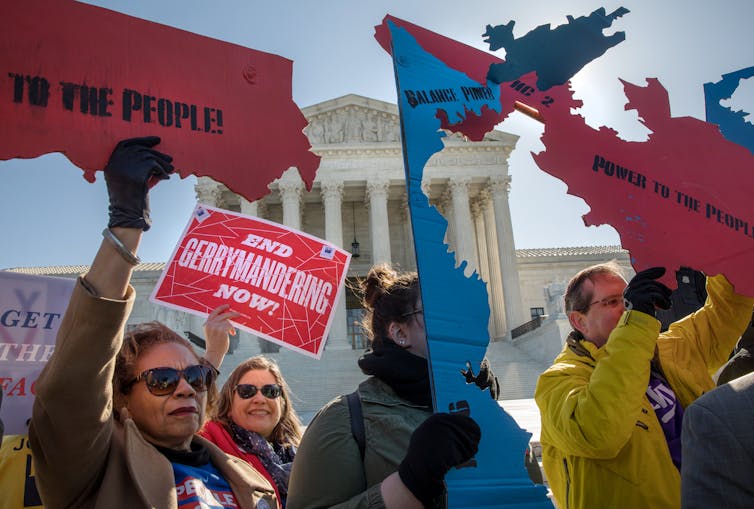
How to make voting districts fair to voters, not parties

Linda Fowler, Dartmouth College and Chris Fowler, Penn State
Should fairness to political parties be the standard for evaluating legislative redistricting?
Across the nation, state lawmakers are jockeying to advantage their party – be it Republican or Democratic – while drawing boundaries for legislative and congressional districts.
If the Freedom to Vote Act currently before Congress passes, many state maps that favor one party will become illegal.
As a geographer who studies boundaries and a political scientist who studies Congress, we are interested in how spatial distributions of voters affect election outcomes.
Our research on Pennsylvania demonstrates that fairness to parties in drawing legislative districts is an unworkable goal. However, reforming other rules that govern how districts are drawn and votes are counted could make more contests competitive and enhance legislators’ accountability to the public.
The case of Pennsylvania
The conventional standard for assessing the partisan fairness of district maps is the seat/vote ratio. This measure reflects a party’s control of seats after an election in proportion to its share of the aggregate state vote.

Take Pennsylvania, for example. Republicans held 72% of the state’s 18 U.S. House seats at the start of the 115th Congress in 2017, while winning only 54% of the aggregate vote. That’s a seat/vote ratio of 72/54. The state Supreme Court viewed the outcome as evidence of biased districting and ordered new congressional maps. The result was a 50-50 partisan split in seats for 2018 and 2020, which proved consistent with Biden’s win of 50% of the votes in the 2020 presidential election.
Beneath this seemingly equitable result, however, were disturbing patterns. In two-thirds of the Pennsylvania races, the winner captured 60% or more of the vote against a weak opponent. In other words, fairness to parties meant that large numbers of citizens in Pennsylvania lived in safe districts where their vote had little meaning. Certain seats, in effect, belonged to one party or the other.
To understand the factors distorting election outcomes in Pennsylvania, we used a computer algorithm to simulate thousands of congressional maps. Without significantly manipulating district boundaries – a process you could describe as reverse gerrymandering – we could generate very few districts where candidates from either party could win. Our work confirmed what others have also found: that the traditional requirement for compactness – meaning districts resemble squares and have straight borders – increased the likelihood that a plan would be biased in favor of Republicans.
Choices voters make
Housing patterns turned out to be the reason behind this dearth of competitive contests.
Voters in Pennsylvania cluster into homogeneous communities according to socioeconomic status, race and partisan affiliation, a phenomenon known as “residential sorting.” Once a dominant group emerges in a district, potential challengers lack a viable path to office and decide not to run. Incumbents become accountable solely to primary voters, while large numbers of citizens sink permanently into political irrelevance.
Across the nation, similar patterns prevail. Typically, only 10% to 12% of the 435 House districts have closely fought contests, and few state legislatures experience shifts in party control. For example, the Maryland state Legislature has been in Democratic hands for at least 30 years, despite having had two Republican governors.
One might justify fairness to parties as a criterion for redistricting by arguing that voters rely on party labels to evaluate candidates. But public approval of both the Democratic and Republican parties has averaged well below 50% since 2010, and a July 2021 Gallup Poll showed independents as the single largest group of voters, at 43%. Among young voters, 43% affiliate with Democrats, but only 22% connect to Republicans.
Both parties lack coherent platforms, having lost control over their nomination processes and split internally into factions. Large majorities of Republican and Democratic voters consistently agree with the statement that the country is moving in the wrong direction. Given these trends, privileging fairness to parties and the seat/vote ratio hardly seems a recipe for effective representation in state and federal legislatures.

Strategies that reach beyond the concept of partisan fairness to enhance competition would give voters a stronger political voice. Here are two of the better ideas.
Multimember districts
Many election experts tout multimember districts as a means of reducing the number of safe seats – a view we share. The approach combines several single districts into one larger unit that elects several representatives.
The basic idea is that bigger geographic units generate competition because they contain voters with more varied political interests. With greater diversity, the number of viable electoral coalitions increases. Strong challengers are more likely to run, and neglected communities of interest become more relevant. A clear majority would always capture at least one seat, but any sizable minority would play a significant role in determining the remaining winners.
In our research on Pennsylvania’s 18 congressional districts, a plan with three members in each of six districts generates the greatest number of diverse constituencies. Overall, the probability that a district would be competitive improved, although the scale of residential sorting in and around Philadelphia, particularly for Black Americans, would likely produce at least one politically homogeneous district.
In this system, the number of multimember districts and the members per district would vary by state depending upon its population size, but the number of voters per elected representative would remain constant across the nation.
Ranked-choice voting
To make multimember districts viable we also need to change how winners are declared.
Currently elections in the U.S. are decided by plurality, meaning the winner needs only one vote more than the closest rival to win. A majority of votes isn’t needed. Particularly in multicandidate contests, the current plurality system awards victory to candidates with intense, but narrow, appeal.
Ranked-choice voting, however, allows voters to express their preferences for the candidates who are not their first choice. Under such a system, candidates have incentives to broaden their messages to capture votes from citizens who rank them second or third. Most analysts think that ranked-choice voting makes it less likely for candidates with extreme views to win compared with candidates with broader appeal. The Democratic primary for New York City mayor in 2021 followed this pattern, selecting Eric Adams, who was acceptable to multiple groups.
[Get the best of The Conversation, every weekend. Sign up for our weekly newsletter.]
One group that may oppose multimember districts is Black voters. Eliminating single-member districts could interfere with the design of districts with a majority of African American voters – districts that have fostered the election of Black legislators since the 1960s.
When we studied the districts that elected Black members to Congress, however, we learned that those containing at least 37% African Americans selected a Black candidate in most cases. And research done at the Tisch College of Civic Life at Tufts University indicates that Black and Latino citizens may benefit from multimember districts if they are adopted in combination with ranked-choice voting.
Elections should hold public officials accountable by rewarding or sanctioning legislators’ performance. Outlawing gerrymandering addresses one piece of the problem of safe seats that impedes representation. But without other reforms, fairness to parties will have limited impact as long as residential sorting of citizens into homogeneous communities stifles electoral competition.![]()
Linda Fowler, Professor of Government, Dartmouth College and Chris Fowler, Associate Professor of Geography and Demography, Penn State
This article is republished from The Conversation under a Creative Commons license. Read the original article.

















